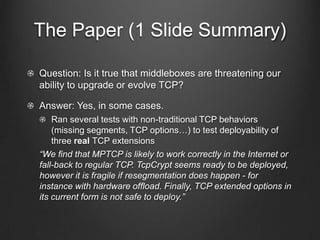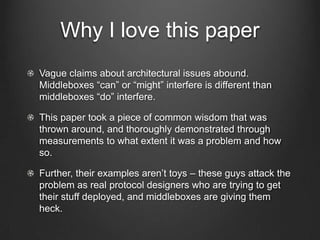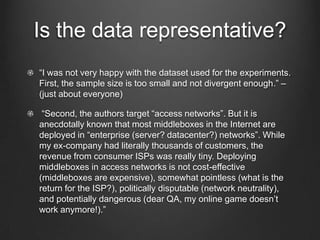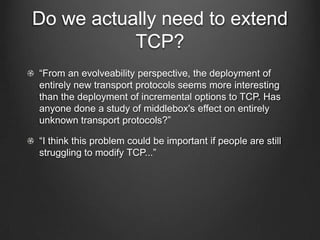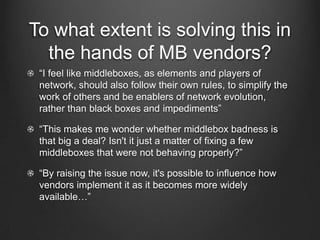Middlebox hate blog
- 1. Middleboxes: Why all the Hate? Justine Sherry (Neither taking nor TAâing this class, but somehow presenting.)
- 5. Why all the hate?
- 6. Why all the hate? âMiddleboxes violate the E2E principle.â âMiddleboxes encourage architectural ossification.â âMiddleboxes create reachability problems.â âItâs like the formerly two-way Internet has a bunch of one- way streets.â âMiddleboxes cause new and wonky failures.â "Middleboxes create management complexity â theyâre just confusing to administer.â
- 7. Quick Taxonomy Architectural Issues Managerial Issues Confusing & One-Way Expensive Complex Streets E2E Reliability Architectural Ossification
- 8. Hold up. These are a lot of issues! Why have middleboxes been so successful despite these problems? Whatâs good about them?
- 9. The Good Stuff The features they provide are desirable! â Security, performance, etc. Ability to impose centralized, unilateral control over protocol usage, resource consumption, etc, /without/ control of end host itself. Ease of deployment .â just âdrop inâ NeverthelessâĶ
- 10. Back to Our Taxonomy Architectural Issues Managerial Issues Confusing & One-Way Expensive Complex Streets E2E Reliability Protocol Ossification
- 11. Back to Our Taxonomy Architectural Issues Managerial Issues Confusing & One-Way Expensive Complex Streets E2E Reliability Protocol Ossification APLOMB (+Steveâs Discussion)
- 12. Back to Our Taxonomy Architectural Issues Managerial Issues Confusing & One-Way Expensive Complex Streets E2E Reliability Protocol Ossification Where Iâm headed with this. Letâs go through these one-by-one.
- 13. The End to End Argument âThe function in question can completely and correctly be implemented only with the knowledge and help of the application standing at the end points of the communication system. Therefore, providing that questioned function as a feature of the communication system itself is not possible. (Sometimes an incomplete version of the function provided by the communication system may be useful as a performance enhancement.) We call this line of reasoning against low-level function implementation the "end-to-end argument." [Saltzer, Reed, and Clark 89]
- 14. The One-Way Street Problem Inbound connections to a host are blocked/filtered by a middlebox, but outbound connections work just fine.
- 15. The One-Way Street Problem Network address translation: Goal: allow multiple âinternalâ hosts to all share a public âexternalâ IP address Problem: When an inbound SYN comes to the shared IP address, how do we know which host to send it to? Firewalls: Goal: protect internal hosts from traffic that appears malicious; e.g., destined to inbound ports that are often abused Problem: What if I really do want to enable SSH logins, host an IRC server, or run an FTP server on my internal server?
- 16. Is the One-Way Street Problem fundamental to middleboxes? Can we design middleboxes to solve the One-Way Street Problem?
- 17. Some Proposals Stuart Cheshire and Marc Krochmal. NAT Port Mapping Protocol (NAT-PMP). RFC Internet Draft. http://tools.ietf.org/html/draft-cheshire- nat-pmp-07 Michael Walfish, Jeremy Stribling, Maxwell Krohn, Hari Balakrishnan, Robert Morris, and Scott Shenker. 2004. Middleboxes no longer considered harmful. In Proceedings of the 6th conference on Symposium on Operating Systems Design & Implementation - Volume 6 (OSDI'04), Vol. 6. USENIX Association, Berkeley, CA, USA, 15-15. Justine Sherry, Daniel C. Kim, Seshadri S. Mahalingam, Amy Tang, Steve Wang and Sylvia Ratnasamy. Netcalls: End Host Function Calls to Network Traffic Processing Services. UC Berkeley Technical Report No. UCB/EECS-2012-175
- 18. Protocol Ossification Aha! Now she gets to the paper: Michio Honda, Yoshifumi Nishida, Costin Raiciu, Adam Greenhalgh, Mark Handley, and Hideyuki Tokuda. 2011. Is it still possible to extend TCP?. In Proceedings of the 2011 ACM SIGCOMM conference on Internet measurement conference (IMC '11). ACM, New York, NY, USA, 181-194.
- 19. Protocol Ossification âThe great virtue of the Internet was always that it was stupid; it did no task especially well, but it was extremely ïŽexible and general, allowing a proliferation of protocols and applications that the original designers could never have foreseen.â [Honda et al. IMC 04]
- 20. Protocol Ossification âTo improve performance, reduce security exposure, enhance control, and work around address space shortages, the Internet has experienced an invasion of middleboxes that do care about what the packets contain, and perform processing at layer 4 or higher within the network.â [Honda et al. IMC 04]
- 21. The Paper (1 šÝšÝßĢ Summary) Question: Is it true that middleboxes are threatening our ability to upgrade or evolve TCP? Answer: Yes, in some cases. Ran several tests with non-traditional TCP behaviors (missing segments, TCP optionsâĶ) to test deployability of three real TCP extensions âWe ïŽnd that MPTCP is likely to work correctly in the Internet or fall-back to regular TCP. TcpCrypt seems ready to be deployed, however it is fragile if resegmentation does happen - for instance with hardware ofïŽoad. Finally, TCP extended options in its current form is not safe to deploy.â
- 22. Why I love this paper Vague claims about architectural issues abound. Middleboxes âcanâ or âmightâ interfere is different than middleboxes âdoâ interfere. This paper took a piece of common wisdom that was thrown around, and thoroughly demonstrated through measurements to what extent it was a problem and how so. Further, their examples arenât toys â these guys attack the problem as real protocol designers who are trying to get their stuff deployed, and middleboxes are giving them heck.
- 23. On to your ģĶīĮģūģūąðēÔģŲēõâĶ
- 24. Is the data representative? âI was not very happy with the dataset used for the experiments. First, the sample size is too small and not divergent enough.â â (just about everyone) âSecond, the authors target âaccess networksâ. But it is anecdotally known that most middleboxes in the Internet are deployed in âenterprise (server? datacenter?) networksâ. While my ex-company had literally thousands of customers, the revenue from consumer ISPs was really tiny. Deploying middleboxes in access networks is not cost-effective (middleboxes are expensive), somewhat pointless (what is the return for the ISP?), politically disputable (network neutrality), and potentially dangerous (dear QA, my online game doesnât work anymore!).â
- 25. Do we actually need to extend TCP? âFrom an evolveability perspective, the deployment of entirely new transport protocols seems more interesting than the deployment of incremental options to TCP. Has anyone done a study of middlebox's effect on entirely unknown transport protocols?â âI think this problem could be important if people are still struggling to modify TCP...â
- 26. To what extent is solving this in the hands of MB vendors? âI feel like middleboxes, as elements and players of network, should also follow their own rules, to simplify the work of others and be enablers of network evolution, rather than black boxes and impedimentsâ âThis makes me wonder whether middlebox badness is that big a deal? Isn't it just a matter of fixing a few middleboxes that were not behaving properly?â âBy raising the issue now, it's possible to influence how vendors implement it as it becomes more widely availableâĶâ
- 27. Are middleboxes the problem? While I agree that it has become difficult to expand network functionality, I am not fully convinced that middleboxes are the primary cause of this problem. Rather, I think the global nature of modern networks is what makes it hard to implement new features: you need to reach global agreement and acceptance, followed by worldwide deployment to make use of new network features. In my mind, middleboxes play an extremely small role in this regard, and thus, I don't fully buy in to the authors' arguments.
- 28. Is it still possible to extend TCP? What do you think? What do the authors think?
- 29. Back to Protocol Ossification: is protocol ossification fundamental to middleboxes? Can we redesign things such that it isnât a problem?
- 30. Whatâs next for middleboxes? Should we throw them out? Follow the status quo? Do something in the middle?
- 31. Justine still loves middleboxes.
Editor's Notes
- #6: Ask the class to list off reasons â perhaps write on whiteboard?
- #8: Colin is going to argue that there is overlap between these two sets of concerns and I think thatâs fair.
- #9: <Discuss>
- #10: <Discuss>
- #11: Colin is going to argue that there is overlap between these two sets of concerns and I think thatâs fair.
- #12: The managerial issues stem from the assumption that middleboxes are the right way to do things, and only deal with making them work well /once we have them/.The architectural issues more challenge whether or not middleboxes, as they stand, are the right way to do things at all.
- #13: The managerial issues stem from the assumption that middleboxes are the way to do things, and only deal with making them work well /once we have them/.The architectural issues more challenge whether or not middleboxes, as they stand, are the right way to do things at all.
- #14: Do Middleboxes violate End to End? Broader question than just one way streets or ossificationâĶ.
- #15: Assume everyone understands this problem fairly well; can whiteboard it if people are confused.
- #16: Assume everyone understands this problem fairly well; can whiteboard it if people are confused.
- #17: <Discuss>
- #18: I will not describe only but briefly, putting the cites here so that people can look up later if they want.NAT-PMP â is a per-MB solution; the later two are research proposals that suggest big architectural changes.
- #23: I agree that the middle is super detailedâ but that is almost a pro for the case. Are we really going to have to worry about this stuff whenever we deploy a new TCP? Shouldnât the Internet just âplay dumbâ and let us be?
- #31: Do Middleboxes violate End to End?



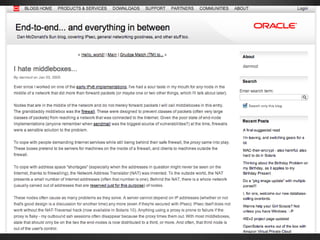
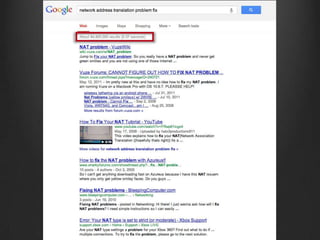

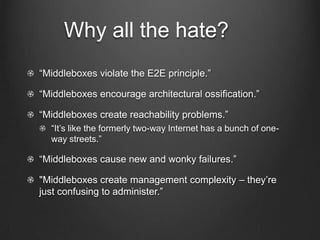


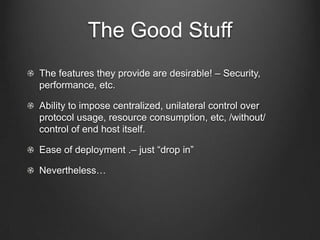


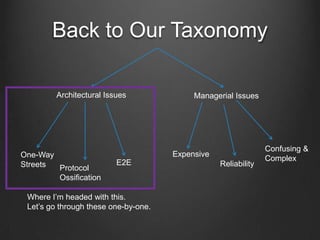
![The End to End Argument
âThe function in question can completely and correctly be
implemented only with the knowledge and help of the
application standing at the end points of the communication
system. Therefore, providing that questioned function as a
feature of the communication system itself is not possible.
(Sometimes an incomplete version of the function provided
by the communication system may be useful as a
performance enhancement.)
We call this line of reasoning against low-level function
implementation the "end-to-end argument."
[Saltzer, Reed, and Clark 89]](https://image.slidesharecdn.com/middleboxhateblog-130306180047-phpapp01/85/Middlebox-hate-blog-13-320.jpg)
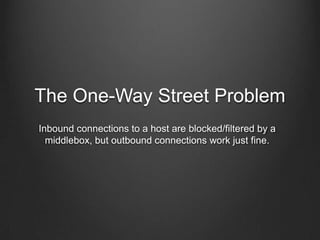
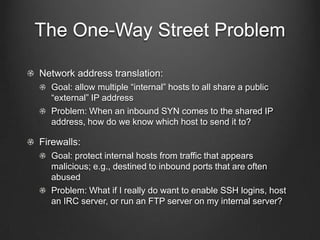
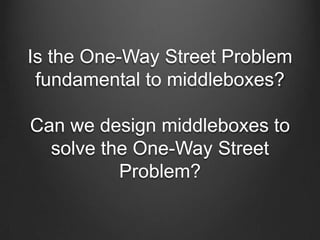
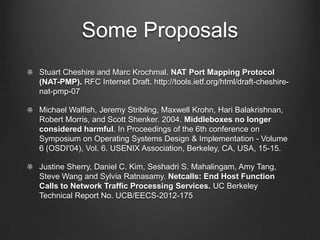

![Protocol Ossification
âThe great virtue of the Internet was always that it was
stupid; it did no task especially well, but it was extremely
ïŽexible and general, allowing a proliferation of protocols
and applications that the original designers could never
have foreseen.â
[Honda et al. IMC 04]](https://image.slidesharecdn.com/middleboxhateblog-130306180047-phpapp01/85/Middlebox-hate-blog-19-320.jpg)
![Protocol Ossification
âTo improve performance, reduce security exposure,
enhance control, and work around address space
shortages, the Internet has experienced an invasion of
middleboxes that do care about what the packets contain,
and perform processing at layer 4 or higher within the
network.â [Honda et al. IMC 04]](https://image.slidesharecdn.com/middleboxhateblog-130306180047-phpapp01/85/Middlebox-hate-blog-20-320.jpg)
